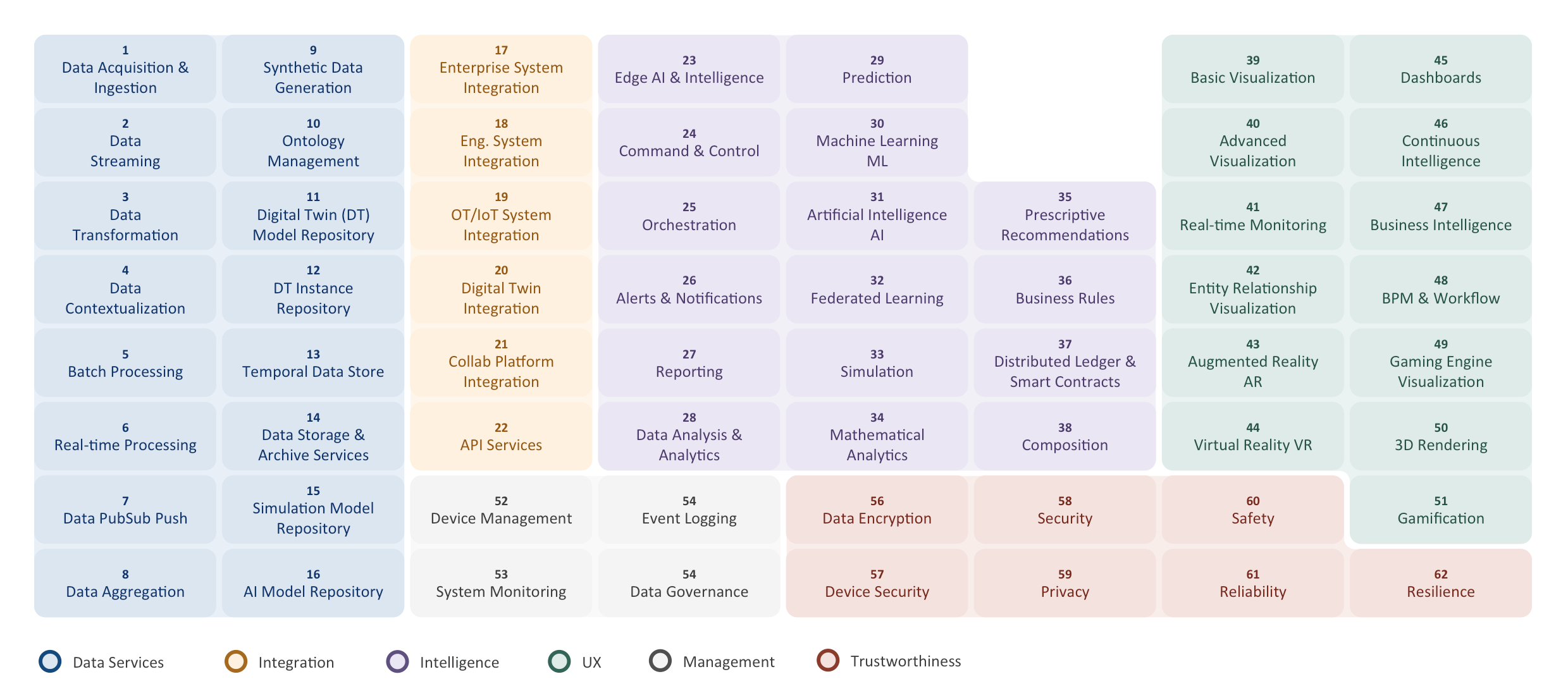Navigating Business Transformation with Digital Twins in Oil and Gas — A Strategic Framework
/By: Kelly Watt, Co-Founder of Digital Twin Consulting
From crowdField
This article, the first in an ongoing series, delves into the strategic application of digital twins within the oil and gas industry and leverages insights from Digital Twin Consulting for successful deployments. It emphasizes strategic planning to tackle real business problems effectively. A focus on clearly defined business problems, prioritized use cases, an agile implementation approach, and a commitment to operational and procedural change are essential for the successful realization of value-delivering digital twins.
The Critical Role of Digital Twins for Oil and Gas
Amid the whirlwind of technological innovation and escalating environmental expectations, the oil and gas sector is at a critical juncture. The industry is grappling with the pressures of shifting market demands, operational challenges, and the urgent need for environmentally sustainable methodologies. Against this backdrop, the concept of the digital twin has surfaced as a pivotal tool for strategic innovation.
Yet, the adoption of digital twins is fraught with obstacles, including complexities, data integrity concerns, technological dependencies, and the overwhelming array of technological solutions. Determining which business problems to address, deciphering technical dependencies, allocating resources, managing business process changes, and selecting supportive technologies pose significant challenges in realizing genuine business transformation.
At the heart of these challenges lies the crucial goal of maintaining business profitability amidst fluctuating market trends, policy regulations, technological advancements, and investment dynamics. Industry leaders find themselves navigating a delicate balance, torn between the allure of cutting-edge technologies and the risk of adopting solutions that may not yield substantial business value.
Want to hear more about how to successfully implement & scale digital twins in the energy sector? Catch up with Kelly and other experts at the Industrial Digital Twin Forum, co-located with the Energy Drone & Robotics Summit, this June 10-12 in Houston, TX.
The Digital Twin as a Strategic Framework
At its essence, a digital twin is a dynamic digital replica of physical assets, systems, or processes that enable the simulation, analysis, and control of real-world operations via virtual models. This strategic framework, which marries data with spatial information and business processes, incorporates intelligence, automation, and simulation elements to foresee and refine outcomes. The digital twin as a strategic framework delivers a continually current foundation for strategic decision-making and operational efficiency.
However, organizations struggle with the concept of a digital twin—where to start, what data is required, and how to realize business success.
There is an elusive mystery to the term “digital twin,” which generates anticipated expectations as its definition is very comprehensive. The reality is that your current business systems and new technology purchases will not produce all the defined benefits offered in the digital twin out of the box, no matter what your vendors tell you. The digital twin is a journey you need to best define for yourself as an organization and evolve to the future state you expect in phases and over time.
Defining The Path Forward: Strategic Master Planning and Needs Assessment Support Digital Twin Adoption
The journey toward the adoption of digital twins begins with Strategic Master Planning. This foundational phase is paramount for grasping leadership's critical issues and steering clear of a technology-first mindset. The strategic focus is to enhance the organization's capability to generate business value, fostering a shared understanding, a unified language, and clear distinction on the use cases that are beneficial for digital twinning (whether in 2D or 3D) and those that are not.
Strategic Master Planning includes an in-depth assessment of business needs, encompassing workshops with diverse stakeholders and analysis of current operational processes, standards, and governance. As a result of this operations needs assessment, use cases are identified, analyzed, and prioritized.
A detailed needs analysis is crucial for delineating the present maturity of data, infrastructure, and processes involved in individual use cases. True business implications and dependencies of use cases delineate where value potential exists. It serves to identify current strengths, pinpoint deficiencies, and reveal areas where digital twins can contribute substantial business value.
Financial and technology assessment is critical for each use case. Financial analysis projects potential impact on revenues, cost savings, cost avoidance, sustainability objectives, or other measurable benefits to each use case, such as safety improvements, security, and risk mitigation. Technology implications are evaluated by analyzing data quality and availability, systems integration, technological discrepancies, compliance with enterprise data policies, and the need for modifications in business processes.
The defined use cases are prioritized based on data requirements, recognizing dependencies, the level of complexity, and the potential value expected from each use case. This prioritization is then subject to feedback from leadership and business stakeholders before decisions are made on the initial deployments.
A great source for use case inspirations is The Digital Twin Capabilities Periodic Table (CPT) which is an architecture and technology agnostic requirements definition framework.
Crafting Agile Technical Project Roadmaps
After laying the groundwork with strategic master planning, the next step involves crafting agile technical project roadmaps. These roadmaps, built on iterative developments that deliver incremental business value and require phased approvals, represent the clear and realizable paths forward. Projects aimed at modernizing operations present a prime opportunity for transformation, whether they originate from innovation initiatives or are tied to specific business use cases in their initial stages.
Effective roadmaps incorporate an understanding of necessary technological infrastructure, including data communication protocols, integration strategies, timelines, budgeting, procurement processes, resource allocation, and the development of analytics and simulation tools for stakeholders. Concurrently, applicable business process changes that engage directly in the field to maximize the likelihood of adoption and overcome barriers.
Identifying dedicated champions for each use case deployment is critical, spanning executive leadership, senior management, and user levels throughout the project. Their engagement is vital for the project's success and sets a precedent for future initiatives.
It's also important to recognize that a project might encompass multiple use cases, impacting various stakeholders. During the rollout, efforts should be made to simplify complexity and validate assumed benefits through continuous feedback, ensuring the early and practical applied success of the digital twin. This approach allows for positive change to be reinforced or lessons learned from setbacks, adjusting strategies to address the core business challenges effectively.
Conclusion
A leader in the digital twin space, Pieter Van Schalkwyk, CEO of XMPro and Chair of the Natural Resources Working Group in the Digital Twin Consortium, recently highlighted the profound impact of Intelligent digital twins, noting, "The most significant benefit of an intelligent digital twin is its ability to actively and continuously augment human decision-making processes." This underscores the transformative potential of digital twins when aligned with strategic objectives. The roadmap to digital twin maturity is not only a technological journey but also an organizational one, demanding dedication and foresight. This digital twin journey is unique to the business, prioritizing business problems and being executed through defined use cases. The potential for optimization, innovation, and strategic growth makes this journey well worth undertaking, promising a future where the oil and gas industry thrives through agility, efficiency, and resilience.
About the Author
Kelly Watt, Digital Twin Consortium
Kelly Watt is an accomplished Digital Twin Consultant and the pioneering co-founder of Digital Twin Consulting. He is known for developing the "Digital Twin Assessment Process DPTAP" and providing reality capture and technology services. His work primarily concentrates on enhancing 3D visualization and advancing digital transformation, effectively bridging the divide between visionary leadership and technological firms. Through strategic planning, master planning, detailed technical project roadmaps, and collaborative program management, Kelly and his dedicated team facilitate the successful implementation of digital twin technologies.
Presently, Kelly oversees sophisticated digital twin initiatives at DFW Airport and AIFA Airport. He has vast expertise across various sectors such as oil and gas, energy, manufacturing, government, transportation, and aviation. Recognized as a thought leader and a regular contributor to the digital twin and 3D community, he often shares his insights as a speaker at industry events. His specializations include 3D lidar, photogrammetry, video imaging, and analysis technologies, and he is certified as a level 1 thermographer with skills in spectral imaging, condition-based asset monitoring, and reliability centered maintenance.
Kelly Watt serves as an Ambassador for the Digital Twin Consortium in the Mobility and Transportation sectors while supporting the oil and gas and resource sectors. This role further highlights his commitment to driving forward the application and development of digital twin technologies within these critical areas of global infrastructure.
Kelly is also deeply involved in developing digital twin programs using knowledge graphs and semantic models, providing a robust foundation for these initiatives. Committed to the dissemination of knowledge, he has created a comprehensive digital twin course aimed at educating the industry workforce on the core principles, components, and techniques of digital twin technology. This course is remotely offered at a leading Canadian engineering college, further extending his impact on the field.





